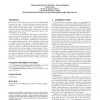Free Online Productivity Tools
i2Speak
i2Symbol
i2OCR
iTex2Img
iWeb2Print
iWeb2Shot
i2Type
iPdf2Split
iPdf2Merge
i2Bopomofo
i2Arabic
i2Style
i2Image
i2PDF
iLatex2Rtf
Sci2ools
SIGMETRICS
2008
ACM
2008
ACM
Traffic capacity of multi-cell WLANS
Performance of WLANs has been extensively studied during the past few years. While the focus has mostly been on isolated cells, the coverage of WLANs is in practice most often realised through several cells. Cells using the same frequency channel typically interact through the exclusion region enforced by the RTS/CTS mechanism prior to the transmission of any packet. In this paper, we investigate the impact of this interaction on the overall network capacity under realistic dynamic traffic conditions. Specifically, we represent each cell as a queue and derive the stability condition of the corresponding coupled queuing system. This condition is then used to calculate the network capacity. To gain insight into the particular nature of interference in multi-cell WLANs, we apply our model to a number of simple network topologies and explicitly derive the capacity in several cases. The results notably show that the capacity gain obtained by using M frequency channels can grow significantl...
| Added | 15 Dec 2010 |
| Updated | 15 Dec 2010 |
| Type | Journal |
| Year | 2008 |
| Where | SIGMETRICS |
| Authors | Thomas Bonald, Ali Ibrahim, James Roberts |
Comments (0)

